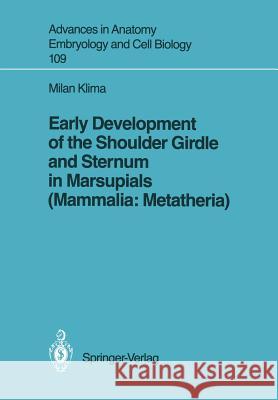Early Development of the Shoulder Girdle and Sternum in Marsupials (Mammalia: Metatheria) » książka
Early Development of the Shoulder Girdle and Sternum in Marsupials (Mammalia: Metatheria)
ISBN-13: 9783540183587 / Angielski / Miękka / 1987 / 91 str.
Early Development of the Shoulder Girdle and Sternum in Marsupials (Mammalia: Metatheria)
ISBN-13: 9783540183587 / Angielski / Miękka / 1987 / 91 str.
(netto: 384,26 VAT: 5%)
Najniższa cena z 30 dni: 385,52 zł
ok. 22 dni roboczych
Bez gwarancji dostawy przed świętami
Darmowa dostawa!
The development of the breast-shoulder apparatus in the Marsupialia was inves- tigated and compared with the conditions in Monotremata and Placentalia. The results were achieved by the investigation of material comprising altogether 109 histological serial sections of intrauterine embryos, neonates, and pouch young from 11 marsupial species. Additionally, 54 skeletons of subadult and adult marsupials from 25 species were included for comparison. The embryonic states show a strong similarity to the developmental stage of the breast-shoulder apparatus in the monotremes. In contrast, the adult breast-shoulder apparatus generally corresponds to that in placentals. The following elements can be observed in the marsupial breast-shoulder apparatus during embryogenesis: scapula, metacoracoid, procoracoid, first rib, paired sternal elements, unpaired sternal element, and clavicle. All the elements mentioned together form a compact, continuous arch in both the intrauterine embryos and the neonates. In the pouch young, this arch is reduced rather soon after birth, so that a compact connection between the left and the right half of the body no longer exists. All that remains is a loose connection via the clavicle. The metacoracoid becomes the processus coracoideus scapulae. The procoracoid becomes the praeclavium. The unpaired sternal element fuses with the paired sternal element, generating the uniform manubrium sterni. The first rib takes its usual position in the thorax. In the pouch young, the breast- shoulder apparatus as a whole already shows all the typical characteristics that can be determined in adults.











